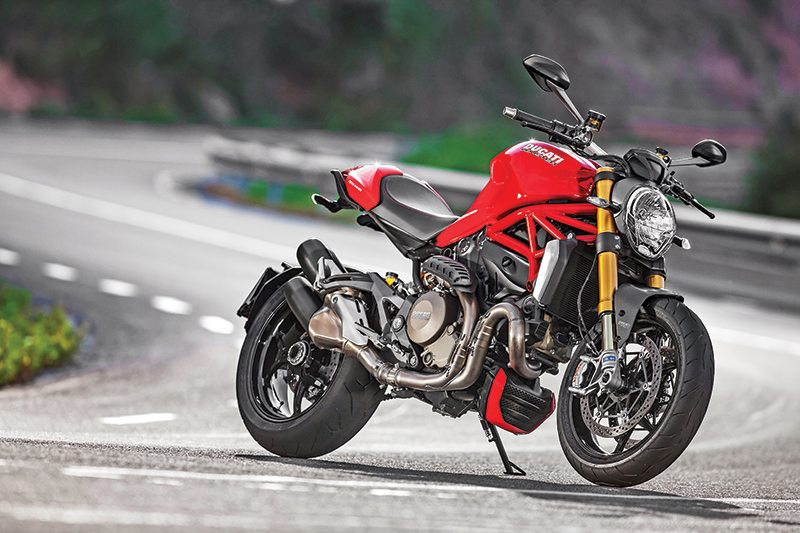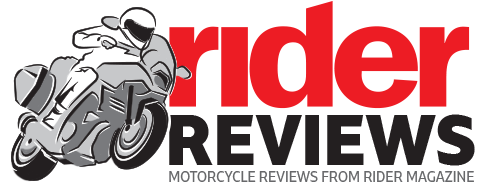2014 Ducati Monster 1200 S

First Ride Review
Now in its early twenties, the Ducati Monster is truly in the prime of its life. Like a star tennis player, the Monster’s winning combination of raw performance, athletic build and ample sex appeal has helped it succeed in a way that few naked bikes have here in the U.S. For 2014, Ducati offers four versions of the Monster—the 696, the 796 and, replacing the 1100EVO, the all-new 1200 and 1200 S. Both versions of the Monster 1200 offer more power and torque, stronger chassis and more advanced technology than any Monster to date, as well as more comfort, safety and versatility.
What distinguishes the 1200 from the 1200 S? The base model ($13,495) makes a claimed 135 horsepower at the crank and has a Kayaba fork and Sachs shock, Brembo M4.32 Monobloc radial front calipers with 320mm discs and 10-spoke cast aluminum wheels. An extra $2,500 for the 1200 S gets you 145 horsepower, fully adjustable Öhlins suspension, Brembo M50 Monobloc radial front calipers with 330mm discs (like the 1199 Panigale superbike), six-spoke machined aluminum wheels, a carbon fiber front fender and black silencers instead of silver. Naturally, only the primo 1200 S was on hand at Ducati’s world press launch in Tenerife, one of the Canary Islands off the northwest coast of Africa.
Motive force is generated by Ducati’s liquid-cooled, 1,198cc Testastretta 11˚ L-twin that, in different states of tune, powers the Multistrada adventure tourer and Diavel power cruiser. Now in its second generation, the Testastretta 11˚ features dual spark plugs, repositioned fuel injectors and a secondary air system for smoother, more fuel efficient performance. For Monster 1200 duty, Ducati bumped the compression ratio up a point to 12.5:1 and used smaller, 53mm round (rather than oval) throttle bodies, lowering horsepower and torque above 7,500 rpm but raising output at lower revs, a very worthwhile tradeoff.
As good as the Testastretta 11˚ engine is in the Multistrada and Diavel, it’s even better in the Monster 1200, with tons of low-end grunt and Ducati’s signature, pulse-raising sound and feel. Like those other models, the Monster 1200 has a 6-speed transmission, chain final drive and the Ducati Safety Pack, which includes three-mode ABS, eight-level traction control and riding modes—Sport, Touring and Urban—that automatically adjust power, throttle response, ABS sensitivity and TC intervention. ABS and TC settings can be customized within each mode, or they can be turned off.
The Monster 1200’s steel trellis frame, subframe and rear shock are bolted directly to the engine’s cylinder heads. Compared to the Monster 1100EVO (Rider, October 2012), the 1200’s frame is lighter and more rigid, and its fuel tank is larger (4.6 gallons, up from 3.6) and is now made of steel instead of plastic. It also has a longer wheelbase (59.5 inches, up from 57.1), and a lower center of gravity with more rearward weight bias and more trail (3.7 inches, up from 3.4; rake is unchanged at 24 degrees). Stability is up, flickability is down, in part due to serious weight gain: 461 pounds ready to ride (claimed), up from 395 (the 1100EVO tipped our scales at 414 pounds, so the 1200 will probably weigh closer to 480).
The Monster 1200 is bigger and more powerful, but also more refined. Whereas the 1100EVO ran rough below 4,000 rpm, the 1200 chugs along smoothly at lower revs. Its hydraulic slipper clutch is now wet instead of dry and has an assist function, making gear changes a snap. The handlebar is 1.6 inches taller and 1.6 inches closer to the rider, improving comfort. The seat is wider and thicker, and height can be adjusted from 30.9-31.8 inches (or opt for the 29.3-inch or 30.1-inch accessory seats). Passenger accommodations are more generous and large grab rails are standard. The full-color TFT instrument display is crisp, clean and easy to read, and there’s a unique layout for each riding mode. Heck, even service intervals are longer—9,000 miles for oil changes, 18,000 for valve adjustments.
Our test route covered the gamut, from urban traffic and a multi-lane expressway along the coast to tight, technical roads that climbed up into the mountains and back down again. Guard rails, cement blocks and volcanic rock lining the roads, some with sketchy pavement, left little margin for error. But the new Monster 1200 S took it all in stride, its robust chassis and blue-chip suspension staying cool and composed. Ultra-strong brakes with a bite that isn’t too aggressive proved perfect for imperfect conditions, the Pirelli Diablo Rosso II tires gripped the road well and the ABS and TC provided a backstop of reassurance. Windblast is what you would expect from a naked bike, but a windscreen—as well as saddlebags and other touring accessories—is available. Some engine vibration blurs the mirrors at times, but I never found it bothersome. My one gripe is that, when riding on the balls of my feet, the passenger peg brackets got in the way, forcing my heels outward.
As with its likely buyer, Ducati’s biggest Monster has matured, offering grown-up levels of performance, sophistication and comfort without being dull or seeming over-the-hill. The Monster 1200 is still as exotic and sexy as ever, especially the high-zoot S model, but now it’s much easier to live with.
